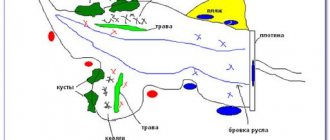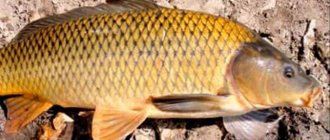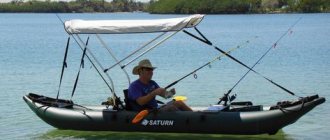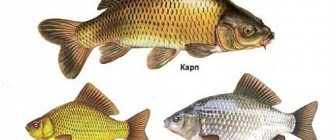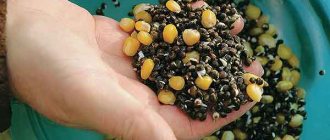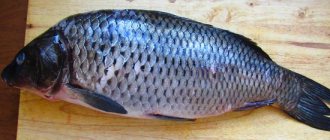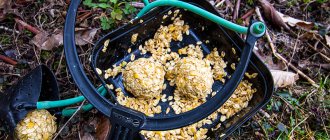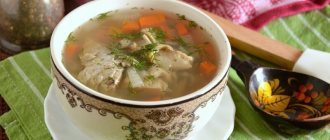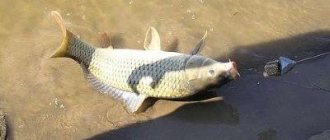Carp is a genus of bony freshwater fish of the carp family. It is believed that the fish received its name for its preference to settle in bays and shallows overgrown with plants with stagnant water (in various Turkic languages the word is translated as “silt”, “swampy place”, “clay soil”).
The historical habitat of the carp was limited to water bodies belonging to the basins of the Azov and Caspian seas. It could also be found in the southeastern part of Asia. Over time, the species spread to Central Asia and the southern and central regions of Siberia.
What does carp look like?
The body of adult individuals is dense, round, slightly elongated. The back is wide, the sides are flattened. The large head has a small hump and the mouth is low. The carp's lips are large and fleshy, the upper lip is noticeably longer than the lower. The fish has two pairs of whiskers, with which it probes the surface of the bottom in search of food.
The carp uses pharyngeal teeth to grind food. They are quite large with flat rims, arranged in three rows. With their help, the fish grinds the shells of crustaceans raised from the bottom, shells of mollusks, and solid plant foods.
The scales of the carp are large, shiny, and have a characteristic color: inside each scale there is a noticeable dark spot, the outer edge has a darker edge.
The dorsal fin is long, with a spike-like protrusion at the beginning. According to this external characteristic, carp are distinguished from other cyprinids. The pectoral and anal fins can be purple, dark red or bluish in color.
Varieties of carp
Currently, there are two subspecies of fish according to their habitats:
- European or Caspian carp . The fish lives in fresh water bodies of the Aral and Caspian basins. River populations periodically descend to deltas and emerge into sea bays with low levels of salt concentration in the water.
- Amur carp . This variety of carp is common in the Far East and Asia.
Difference between carp and other carp species
Carp is the closest relative and the original biological form for another member of the family - carp. The carp living in rivers and lakes was caught and released into small natural and artificial ponds and pools. As a result of selection, an improved domesticated form of carp appeared, which began to be called carp. To separate wild and domesticated species, the following Latin names are used: carp - Cyprinus carpio , carp - Cyprinus carpio carpio .
Despite the great external similarity, there are several signs that allow you to determine what species the fish belongs to.
How does carp differ from carp?
The body height of the carp is higher, due to which it appears more massive in appearance. Carp have an elongated body shape. You can also distinguish fish by the color of their scales: the back of the carp has a darker shade, and as it approaches the abdomen it becomes lighter. In carp, the color of the scales throughout the body practically does not change.
This representative of the order differs from other related species (grass carp, ide, asp, crucian carp) by the presence of a mustache on the lower jaw.
Habitat of carp
As for the habitat of the carp, it is similar to that of the carp: as we have already noted, the carp inhabits rivers and lakes, in the warm season it prefers a variety of depths, but more often it is caught in areas with a slow current or in its complete absence, from the depths from 50 centimeters and up to several meters (some fishermen catch carp from holes under 5-10 meters). As the weather gets colder, the carp goes into holes, into deep areas, and in winter its biting stops; in any case, we didn’t catch it in winter.
How big does carp grow?
In its natural environment, carp can grow up to 1 m long and weigh more than 20 kg, but such huge specimens are very rare. In most cases, fishermen's trophies are smaller individuals: the body length is 40-50 cm, and the maximum weight does not exceed 3-4 kg.
How many years does carp live?
The lifespan of carp in nature is 30-35 years. Intensive growth of individuals stops at the age of 7-8 years.
What is the largest carp caught in Russia
In Russia, the record carp was caught towards the end of the 18th century on the Voronezh River in Lebedyansky district. The individual had a mass of 69.6 kg with a length of 1 m and a width of 70 cm. The fish was caught not on an amateur fishing rod, but in a commercial seine. Information about the largest catch is not absolutely reliable, since it was transmitted to the Moscow Society of Hunters and Fishermen by ordinary eyewitnesses.
The official record for catching a record large carp in the Russian Federation was recorded in 1996. This happened on the Volga River in the Narimanovo area. The treasured trophy weighed 48 kg. However, unfortunately, it was not possible to find out the name of the lucky fisherman.
Important! Today it is possible to catch a really big carp in Russia only in the Far East or in the Astrakhan region.
Every year, information about catching carp weighing more than 15 kg is becoming less and less common. Fishing according to the “Catch and Release” rule can improve this situation - only then can slow-growing fish reach their maximum size.
Habits of carp
Most members of the population live in one place in rivers or lakes. The semi-anadromous carp is capable of migrating: in the spring it goes out to sea, populating shallow waters with slightly salty water, and rises to the mouths of rivers for spawning and wintering.
The species is a schooling fish. The number of groups directly depends on age and size: fry move in schools of 80-100 individuals, young carp form schools of 20-30 males and females, adults - of 5-8.
Representatives of the species have good eyesight and hearing, so any movement or noise can scare away the cautious carp. He is quite picky about food and does not grab food right away, but tries it first. This feature should be taken into account when fishing.
Carp are able to warn their flock of possible danger. The sound that the fish makes is similar to the crunching of dry branches.
How to choose and how to store
Before you buy fish in a store, you need to choose it carefully. Particular attention is paid to the shelf life of the product.
Of course, even after one freeze, the product loses some of its nutrients. Therefore, it is better to buy carp fresh or chilled.
You can tell the freshness of fish by the eyes. They should be light, not cloudy. But cloudy eyes almost always indicate that the fish has been stored for a long time.
Next you need to carefully examine the scales. It should not be covered in mucus. Perhaps the fish is already stale or the rules were violated during storage. Also, fresh fish should have scales that are wet.
Another selection criterion is gills. There should be no mucus on them. In a fresh carcass they are deep red in color. This fish was caught recently and is fresh.
And finally, you should pay attention to the meat. If the carp is large in size, then it can be sold in pieces. This carcass is worth sniffing.
Fresh product smells like a river. You can determine freshness by pressing on the meat with your finger. In a fresh product it will be restored immediately. There are no recesses left.
It is allowed to store carp in the refrigerator. If the fish was purchased chilled, then it must be stored at a temperature of -2 degrees. Deviations are allowed, but no more than +2 or -2 degrees. The temperature in the refrigerator is often higher, so it should not be stored for more than one day.
To store in the freezer, the product is washed, dried, and the insides are removed. Carp can be stored frozen for up to 7 months.
Carp baked whole in the oven
Carp spawning
For spawning, carp choose shallow water with a lot of vegetation. Mature individuals begin searching for a suitable place 2-3 weeks before breeding begins. Carp spawning begins immediately after the water temperature rises to +18-20 degrees.
Females spawn in portions, and during the spawning period they are able to lay 1-1.5 million eggs. Fertilized eggs stick to the surface of the algae until the larvae emerge.
The color of carp caviar is light yellow, the eggs have a diameter of 1.5-2 mm. A few days after fertilization, carp larvae are born. In the first days they get everything they need from their yolk sacs. On the 6-7th day of life, the grown fry of the carp leaves the spawning ground in search of food.
Despite the high fertility of females, under natural conditions most of the eggs and the fry that emerge from them die, becoming food for omnivorous and predatory fish.
Feeding and Spawning. Lifestyle of Sazan
When it comes to food, Carp is not picky; it eats both plant foods (Algae, Duckweed, Coastal greens) and protein products (larvae, mollusks, worms, fish and frog eggs, etc. If there is insufficient quantity of this kind of food, it can feed on small fish.
The carp matures at 6 years old. It begins to spawn when the temperature reaches 18°C. During this period, you can observe whole Schools of fish bodies, which arrange real games in the water.
A female carp lays up to 1 million 800 thousand eggs. A larger number die, becoming food for small predators. Only a small part of the young survive to sexual maturity.
How to improve fish bite?
Friends! Over 15 years of active fishing, I have found many ways to improve the bite, and here are the most effective:
2. Tackle with increased sensitivity . You should first familiarize yourself with the features of using a particular type, depending on the fishing method.
3. Pheromone baits . They attract the attention of fish, stimulate hunger and cause a schooling reflex, which allows you to collect a lot of fish in one place.
You can get the rest of the secrets of successful fishing for free by reading my other materials on the site.
How to improve fish bite?
Friends! Over 15 years of active fishing, I have found many ways to improve the bite, and here are the most effective:
2. Tackle with increased sensitivity . You should first familiarize yourself with the features of using a particular type, depending on the fishing method.
3. Pheromone baits . They attract the attention of fish, stimulate hunger and cause a schooling reflex, which allows you to collect a lot of fish in one place.
You can get the rest of the secrets of successful fishing for free by reading my other materials on the site.
Where is the carp found?
The traditional habitat of carp is lakes, ponds, and sections of rivers with calm currents. The fish prefers places with a relief muddy or sandy bottom, a lot of underwater and coastal vegetation, snags, flooded trees and other shelters.
Usually the carp does not swim far from the place where it lives. In the daytime, it prefers to be near the bottom, choosing food from the silt, and at night it can approach the coastline and swim into shallow water.
The unpretentiousness and omnivorous nature of the fish made it possible to breed carp in a pond or artificial reservoir.
Varieties of carp
There are different types of carp depending on the habitat in which it lives. At the same time, the external characteristics of various subspecies of carp do not differ.
European
The habitat of this species of common carp is the basins of the Caspian, Black and Aral seas, as well as the majority of rivers from the Amur to Burma. It is believed that the original source of distribution of this fish to all other zones is the Danube River. This carp is considered the largest: it can grow up to 1 m or more, and also weigh up to 32 kg (with an average of 4 kg).
Amursky
This subspecies is practically no different from the European carp, being simply its Far Eastern relative. You can find it in the middle reaches of the Amur River. The weight of an adult carp can be up to 25 kg with a body length of up to 1 m (the average weight is 2.5–3 kg). Like the European subspecies, it has very high quality meat, which is valued in cooking.
Aral
This subspecies of common carp is found, accordingly, in the Aral Sea basin, although it is also often found in the Caspian Sea, on Lake Issyk-Kul and on the Amur. Prefers places with the quietest currents. Grows on average up to 3 kg.
Vietnamese
You can find this subspecies of carp in Indochina. It is almost impossible to meet large representatives of the Karpov family here. The largest specimens weigh up to 5 kg.
Cyprinus carpio yilmaz
It lives mainly in Australia and eastern Turkey. It is distinguished by its relatively light weight - up to 2.5 kg.
What does carp eat?
The diet of fish depends on the stage of development and time of year. Thus, the larvae that emerge from the eggs feed on plankton and algae particles. Food for adults includes insects, caddis flies, worms, snails, daphnia, fish eggs and fry.
In spring and early summer, plant foods predominate in the carp's diet; from mid-summer, algae and reeds become tough, and the fish switches to live prey.
One of the features of the carp is that it has no stomach, and the length of the intestines exceeds the length of its body. In this regard, the fish feeds almost without interruption and spends the whole day searching for food.
What kind of fish, where is it found, description, types
Despite the fact that carp is considered an inhabitant of freshwater, it can also be found in the seas. For example, common carp are found in the Black, Azov, and Caspian Seas.
Most often, carp lives in ponds, rivers, lakes and reservoirs. The main habitat is the Far East, Central Asia, Kamchatka. Carp does not like fast currents.
It feeds on plant foods, eggs of other fish and amphibians. The common carp is characterized by a memorable appearance. It has golden scales with a blue tint.
The scales on the belly are lighter, and on the back they are darker. The scales have a specific pattern. The fish has a well-developed fin. It runs all the way across your back.
The common carp has a large head with a retractable mouth. Another feature of this fish is its small eyes. The carp has antennae that are located on both sides of the upper lip. There are spines on the fins of the carp. Therefore, you need to be very careful when cleaning the carcass.
The length of a common carp carcass is approximately 30 centimeters. Weight rarely exceeds 3 kilograms. But there are also larger specimens.
There are two main subspecies of carp:
- Amursky,
- European.
Amur - lives in the reservoirs of the Far East and southern Asia, and European - lives in sea basins such as the Aral and Caspian.
Methods of catching carp
The fishing season begins in mid-May and ends in October with the first frost. The peak activity of the heat-loving carp occurs in the summer months. After the temperature in the reservoir drops below +8 degrees, the fish gather in schools, go to depth and remain in a state of suspended animation throughout the winter season: they are covered with mucus, do not move and practically do not breathe.
Active biting is observed when the fish is in comfortable conditions for it: the water is heated to a temperature of +20-25, there are no sharp changes in climatic conditions. On a cold, windy or rainy day, carp prefer to stay in their shelters at the bottom of the reservoir.
Carp are caught in the following ways:
- On the feeder.
- On a bottom fishing rod.
Fishing rods must be durable and able to withstand sudden jerks. A fishing line that is too thick can scare away the carp, and a fishing line that is too thin can not withstand the weight and resistance of the fish. The best option is a fishing line with a cross section of 0.25 mm.
It is better to use forged hooks, this will reduce the likelihood that the fish will straighten it or break it. Depending on the weight of the expected trophy, a hook size from 6 to 14 is used.
The correct choice of bait plays an important role: in early spring, worms, maggots, and leeches are placed on the hook. You can use fish-scented boilies. In summer, carp more actively bite on vegetable bait: steamed grains of corn, pearl barley, and peas. Closer to autumn you should return to live bait.
Bait will help increase the likelihood of a good catch. They throw it at the fishing site regularly and in sufficient portions. To prepare the mixture, use wheat or millet porridge, peas, corn, hemp cake, and crushed worms. Roll the bait mixture into balls and throw them closer to the hooks with bait.
Once hooked, the carp actively resists. When catching this fish, failures occur due to its evasiveness or insufficient strength of gear.
Carp is a very cautious fish. She can partially lose her vigilance only during periods of hunger: before spawning, after the end of spawning and in early autumn before leaving for wintering grounds.
Breeding equipment
When breeding carp in an artificial reservoir, it is recommended to use additional equipment that will make caring for the fish easier.
The list of such devices includes:
- fish cages ;
- filters on the water supply and drainage pipes do not allow carp to slip into the holes;
- compressor or aeration system - needed to enrich water with oxygen;
- automatic feeders - allow you to give food to the carp several times a day at certain intervals;
- oximeter - determines the level of oxygen in water;
- pumps - make it easier to pump water into a reservoir;
- incubators - provide ideal conditions for the successful hatching of fry from fertilized eggs;
- thermometers - allow you to determine the temperature of the water;
- equipment for artificial heating - used when wintering fish in the open air, allowing you to maintain a comfortable temperature in a pond or pool;
- bottom cleaners - help keep the reservoir clean without frequent water changes;
- sterilizer - kills harmful microflora;
- devices for checking the composition of water - allow you to monitor the degree of contamination of the reservoir and clean it in a timely manner.
Did you know? Carp has excellent hearing. Hearing a loud sound or an unpleasant creak, the fish immediately goes to greater depths.
Nutritional value and calorie content of carp
Carp is not classified as a bony fish, since there are almost no small bones in its skeleton. The meat has a dense structure, but at the same time it is quite juicy, tender and has a rich, slightly sweet taste.
The energy value of fillet is 97 kcal per 100 g; its nutritional value is provided by a large amount of vitamins, potassium, phosphorus, and magnesium. The fat content of fish varies depending on the season. The percentage of fat ranges from 3 to 5%. Carp meat is recommended for those who adhere to a salt-free diet, as it contains virtually no sodium.
Due to the small amount of connective tissue, dishes prepared from fish are quickly digested, and the protein they contain provides the body with amino acids, including essential ones.
In cooking, carp carcasses are used for baking and stewing; they are stuffed, fried, and boiled. Minced fish makes tender cutlets, casseroles and soufflés.
Not only meat is eaten, but also carp caviar. It contains lecithin, vitamins, minerals, polyunsaturated fatty acids and is no less healthy than fillet. Traditionally, caviar is salted or fried.
When removing the entrails while cutting fish, it is important not to damage the gall bladder, otherwise the meat will taste bitter.
It is recommended to eat carp fresh, since after freezing it partially loses its taste and beneficial properties.
Carp
Carp is a fish of the carp family, ray-finned class. The body is thick, convex on the sides, and has an elongated shape. The head is large with a steep forehead and a low-set mouth, the upper lip protrudes noticeably forward. The eyes are small and located close to the forehead. The gills are small and bright red inside. At the corners of the mouth there are short, hard antennae, lowered down, which we can see in the photo of the carp fish below. Strong, sharp teeth grow in three rows and have flat rims.
On the back there is a long fin of dark gray color with a jagged ray. The anal and lateral fins are much smaller in size and have a bronze tint. The scales of the carp are hard, round in shape, and fit tightly one to the other. It is painted golden, with dark markings at the base and along the edges. On the stomach it is always lighter than throughout the body. The caudal fin is reddish-brown, with a profile forked to the sides.
Interesting facts about carp
- The largest carp caught in Russia weighed 48 kg. The record specimen was caught in the Volga.
- Carp is included in the list of invasive organisms, since in most cases the introduction of the species into new habitats negatively affects the ecosystem of the reservoirs themselves and nearby areas. Over time, actively reproducing carp displaces the indigenous inhabitants of rivers and lakes, significantly reducing their populations.
- Carp meat has a characteristic rich taste, so it is recommended to use seasonings for cooking: black and white pepper, rosemary, tarragon, marjoram.
- Carp is a smart fish. Thus, carps living in the ponds of the Palace of Versailles learned to pull a rope tied to a bell, indicating that they were hungry.
Interesting facts about carp.
- Due to its low calorie content, carp meat is often included in the diets of people with diabetes.
- There are 4,424 carp-like fish species in the world. If we take it as a percentage of all bony fish in the world, then this amounts to 15% of all fish.
- Carp eat only what it likes. When the fish sucks in the food, it spits most of it back and chooses what it liked. As a rule, the carp spits back most of the food.
- Carp is a smart fish, no matter how strange it may sound. He has a good memory for a fish. Carp may refuse their favorite food if it has been caught on it. This fact has been proven by scientists.
- In 1711, a carp weighing 69.7 kg was caught, but there is no evidence of this.
- In the Moray River, which is located in Australia and is one of the most important rivers on the mainland, carp occupies 80% of the total mass of fish in the river.
Description of carp
The carp is distinguished by a large head, a semi-lower retractable mouth and two short antennae on the upper lip. This fish is equipped with literally “cold weapons” – files in the dorsal and anal fins. Often the carp uses its classic technique, allowing the fisherman to be left with nothing. The carp rushes towards the fisherman, loosens the fishing line, and then catches it and cuts it with a file. This is such a cunning fish - a fisherman's dream.
Carp is found mostly in the southern regions of our country, mainly in the Volga delta, although now it is also found in the middle Volga, as well as in other reservoirs of central Russia. Carp are both a residential species and a semi-anadromous species, living even in the brackish water of coastal areas of the sea near the mouths of rivers and ascending these rivers to spawn.

